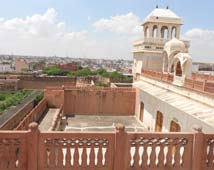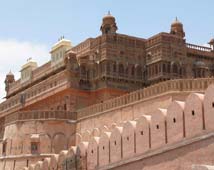
Bikaner, situated in the northern part of Rajasthan, was founded in 1488 by a descendant of the founder of Jodhpur named Rao Bhikaji. Like Jaisalmer, this town was an important city on the great caravan trade route during the medieval period. The city is surrounded by high fortifications comprising a seven-kilometre long wall which encircles the old city and has five entrances—all constructed in the 18th century.The city of Bikaner has seen several ups and downs in its eventful history.
Its proximity to Delhi made it bear the brunt of Mughal invasions time and again. Legend has it that before embarking on his campaign, Rao Bhikaji sought the blessings of mystic Goddess Karni at Deshnoke. Since then the Karni Mata temple in Deshnoke continued to be patronized by the ruling family.
Today hundreds of pilgrims flock the temple everyday to invoke the blessings of the Goddess, who is revered as an incarnation of Goddess Durga. Bikaner is also called the camel country, being renowned for the best riding camels in the world. It is also the birthplace of the world famous Bikaneri bhujia and namkeen (a salted snack made of lentils). Being a desertscape, the summers are very hot in Bikaner. The best time to visit this place is in winters when the weather remains cool and tolerable.

Junagarh Fort in Bikaner
lies to the northeast of the walled old city of Bikaner. Raja Rai Singh, a general in Akbar’s army built the fort in 1593 for the Mughal Army, and its most unusual feature is that this fort was built at ground level and not on high ground. Interestingly, it is one of the few forts in India that was never conquered - maybe its inconspicuousness proved to be it's best defence!
Suraj Pol or Sun Gate, Bikaner
Suraj Pol or Sun Gate is the main entrance to the Junagarh Fort. The fort is encircled by a moat that protects the splendid complex of thirty-seven palaces, pavilions and temples added by different rulers, the last one, as recently as 1943. Their lavishly adorned interiors are much better preserved than those in any other palace in the region.
Lal Garh Palace Bikaner
Lal Garh Palace is an architectural masterpiece in red sandstone, typical of the area. This palace was built by the greatest of Bikaner kings, Maharaja Ganga Singh in the memory of his father Maharaja Lal Singh. The palace has beautiful latticework and filigree work in sandstone that closely resembles lacy confections in its intricacy. Well laid out gardens, sprawling lawns on which peacocks dance and play amidst a riot of colourful bougainvillea make it a delight for the eyes. Part of the palace has been converted into a luxury hotel and a museum.
Ganga Golden Jubilee Museum, Bikaner
Ganga Golden Jubilee Museum is the best amongst the many royal museums in Rajasthan. Its reputation has been enhanced by its rare collection of terra-cotta ware, weapons, miniature paintings from the Bikaner School and coins. Most of the exhibits are masterpieces of Harappan civilization obtained from the archaelogical excavations in the vicinity, as well as some from the Gupta and Kushan periods.

Karni Devi Temple in Bikaner
The temple of Karni Devi is the most important one in Bikaner as it is dedicated to the family deity of the royal house of Bikaner. The Bhandeshwar and Sandeshwar Jain Temples are dedicated to the 23rd Jain Tirthankara, Parsavnathji. Built in the 16th century by two brothers whose names they bear, these temples are remarkable for their colourful murals and the prolific use of gold leaf and mirrors, a rare feature in the Jain temples of Rajasthan.
The excursions around Bikaner, besides giving a glimpse into the region’s culture and history, also provide an insight into the rich flora and fauna. The Gajner Wildlife Sanctuary (32 km from Bikaner) is home to a number of wild species including the nilgai, wild boar, chinkara and flocks of imperial sand grouse that migrate here every winter. Eight kilometres east of Bikaner lies Devi Kund where you can see some ornamented cenotaphs or chhatris.